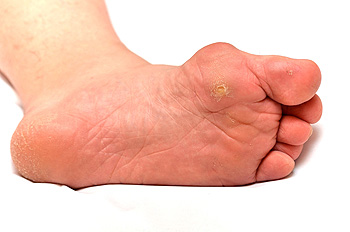
Corns are thickened areas of skin that develop on the feet in response to pressure or friction. They typically form on the toes or soles of the feet and can be caused by wearing ill-fitting footwear, repetitive motion, or abnormalities in foot structure. Symptoms of corns include pain, tenderness, and the presence of a raised, hardened bump on the skin's surface. Prevention strategies include wearing properly fitting shoes, using protective padding or inserts, and practicing good foot hygiene. Podiatric treatment for corns may involve debridement to remove the thickened skin, trimming to reduce pressure, and recommending cushioning products or custom orthotic devices to redistribute weight and alleviate discomfort. In some cases, addressing underlying foot deformities or gait abnormalities may be necessary to prevent recurrence. If you have a corn on your foot and it is causing you discomfort, it is suggested that you consult a podiatrist for care.
If you have any concerns regarding your feet and ankles, contact Lance Greiff, DPM of Great Neck Podiatry. Our doctor will treat your foot and ankle needs.
Corns: What Are They? and How Do You Get Rid of Them?
Corns can be described as areas of the skin that have thickened to the point of becoming painful or irritating. They are often layers and layers of the skin that have become dry and rough, and are normally smaller than calluses.
Ways to Prevent Corns
There are many ways to get rid of painful corns such as wearing:
- Well-fitting socks
- Comfortable shoes that are not tight around your foot
- Shoes that offer support
Treating Corns
Treatment of corns involves removing the dead skin that has built up in the specific area of the foot. Consult with Our doctor to determine the best treatment option for your case of corns.
If you have any questions please feel free to contact our offices located in Great Neck Bronx, NY . We offer the newest diagnostic and treatment technologies for all your foot and ankle needs.
